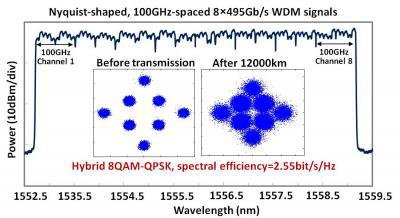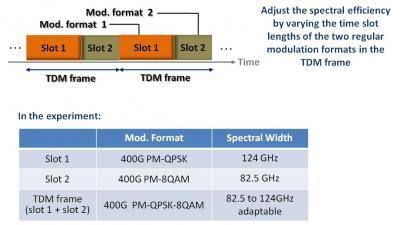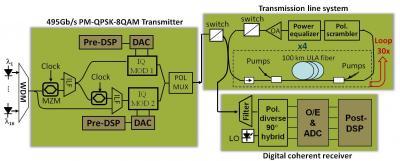As network carriers debate the next Ethernet standard, and whether transmission speeds of 400 gigabit per second or 1 terabit per second should be the norm, engineers are working on new ways to squeeze next-generation performance out of current-generation systems.
A team from AT&T has devised a new technique that enables tuning of the modulation spectral efficiency and allows 400 Gb/s signals to be sent over today's 100 gigahertz-grid optical networks over ultra-long distances.
Spectral efficiency is the information rate that can be transmitted over a given bandwidth, and measures how efficiently the available frequency spectrum is utilized.
In the system, Nyquist-shaped 400Gb/s signals with tunable spectral efficiency were generated using modulated subcarriers. Eight 100 GHz-spaced, 400 Gb/s wavelength-division-multiplexed signals were combined and then transmitted over a re-circulating transmission test platform consisting of 100-km fiber spans.

This shows the measured optical spectrum of the eight 100GHz-spaced 495Gb/s WDM signals at the launch into the transmission fiber. The insets are measured constellation diagrams before and after transmission. QPSK: quadrature phase shift keying; QAM: quadrature amplitude modulation; WDM: wavelength division multiplexed. Image courtesy AT&T Labs
Using the new modulation technique and a new low-loss, large-effective area fiber from OFS Labs, the team transmitted the signals over a record-breaking 12,000 kilometers (roughly 7500 miles)—surpassing their own previous distance record (using the 50 gigahertz-grid) by more than 9000 km.

The proposed optical modulation technique adaptable spectral efficiency. The table lists the modulation formats used in the experiment for time slots 1 and 2, as well as the modulation formats' spectral widths and the resulting range of adaptable spectral width attainable for the TDM frame from the proposed optical modulation technique. TDM: time-division-multiplexed; PM: polarization-multiplexed; QPSK: quadrature phase shift keying; QAM: quadrature amplitude modulation. Image courtesy of AT&T Labs
"This result not only represents a reach increase by a factor of 2.5 for 100 GHz-spaced 400 G-class WDM systems, it also sets a new record for the product of spectral efficiency and distance," says optical transmission system expert Xiang Zhou of AT&T Labs-Research in Middletown, N.J. Compared to modulation techniques currently used, he says, "our method has the unique capability to allow tuning of the modulation spectral efficiency to match the available channel bandwidth and maximize the transmission reach, while maintaining tolerance to fiber nonlinearities and laser phase noise, both of which are major factors limiting performance for high-speed optical systems."

This shows an experimental setup consisting of the 495Gb/s PM-QPSK-8QAM transmitter, the transmission line system implemented in a recirculating loop, and the digital coherent receiver. WDM: wavelength division multiplexer; DSP: digital signal processing; DAC: digital to analog converter; ILF: interleave filter; IQ MOD: in-phase and quadrature modulator; POL MUX: polarization multiplexer; OA: optical amplifier; LO: local oscillator; O/E: optical to electrical converter; ULA: ultra-large area; ADC: analog to digital converter. Image courtesy of AT&T Labs
The researchers will describe their work at the Optical Fiber Communication Conference and Exposition/National Fiber Optic Engineers Conference (OFC/NFOEC) in Anaheim, Calif. March 17th-21st.






Comments